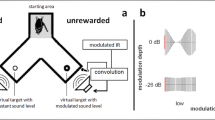Summary
The echolocating bat,Plecotus phyllotis (Vespertilionidae), uses long-CF/FM and FM sonar sounds in different situations. The CF component in long-CF/FM sounds occurs at 27 kHz and has a duration of 20 to 200 ms. The FM component sweeps down from 24 to 12 kHz, with a prominent second harmonic from 40 to 22 kHz. This second harmonic sweep is interrupted at 28 to 25 kHz, providing a notch in the spectrum of the FM component at the CF frequency. This notch probably permits isolation of CF and FM components in echoes for separate processing, thus avoiding mutual interference with the different kinds of target information the two components convey. The FM component is also used without the CF component as a sonar sound. Two other FM orientation sounds are used when the bat is in a confined space such as a room. One contains only the second and fourth harmonics of the 24 to 12 kHz fundamental sweep, while the other contains only the fifth harmonic. This bat's repertoire of sonar sounds closely matches the hearing capacities of the genus.
Similar content being viewed by others
References
Altes, R.A.: Angle estimation and binaural processing in echolocation. J. acoust. Soc. Amer., in press (1977)
Bruns, V.: Peripheral auditory tuning for fine frequency analysis by the CF-FM bat,Rhinolophus ferrumequinum. II. Frequency mapping in the cochlea. J. Comp. Physiol.106, 87–97 (1976)
Ehret, G.: Temporal auditory summation for pure tones and white noise in the house mouse (Mus musculus). J. acoust. Soc. Amer.59, 1421–1427 (1976)
Fenton, M.B.: The structure of aerial-feeding bat faunas as indicated by ears and wing elements. Canad. J. Zool.50, 287–296 (1972)
Griffin, D.R.: Listening in the dark. New Haven, Conn.: Yale Univ. Press 1958
Griffin, D.R.: The importance of atmospheric attenuation for the echolocation of bats (Chiroptera). Anim. Behav.19, 55–61 (1971)
Griffin, D.R., McCue, J.J.G., Grinnell, A.D.: The resistance of bats to jamming. J. exp. Zool.152, 229–250 (1963)
Griffin, D.R., Simmons, J.A.: Echolocation of insects by horseshoe bats. Nature (Lond.)250, 731–732 (1974)
Grinnell, A.D.: The neurophysiology of audition in bats: intensity and frequency parameters. J. Physiol. (Lond.)167, 38–66 (1963)
Grinnell, A.D.: Neural processing mechanisms in echolocating bats, correlated with differences in emitted sounds. J. acoust. Soc. Amer.54, 147–156 (1973)
Johnson, R.A., Henson, O.W., Jr., Goldman, L.R.: Detection of insect wing beats by the bat,Pteronotus parnellii. J. acoust. Soc. Amer.55, 853 (1974)
Koopman, K.F.: Zoogeography of bats. In: About bats (eds. B.H. Slaughter, D.W. Walton), pp. 29–50. Dallas, Tex.: Southern Methodist Univ. Press 1970
McCue, J.J.G., Bertolini, A.: A portable receiver for ultrasonic waves in air. Transactions I.E.E.E., Sonics and UltrasonicsSU-11, 41–49 (1964)
Pye, J.D.: Some preliminary observations on flexible echolocation systems. Ann. E. Afr. Acad. Sci., in press (1977)
Schnitzler, H.-U.: Die Echoortung der Fledermäuse und ihre hörphysiologischen Grundlagen. Fortschr. Zool.21, 136–189 (1973)
Schnitzler, H.-U., Suga, N., Simmons, J.A.: Peripheral auditory tuning for fine frequency analysis by the CF-FM bat,Rhinolophus ferrumeqinum. III. Cochlear microphonics and auditory nerve responses. J. comp. Physiol.106, 99–110 (1976)
Schuller, G.: Echoortung beiRhinolophus ferrumequinum mit frequenzmodulierten Lauten. Evoked potentials im Colliculus inferior. J. comp. Physiol.77, 306–331 (1972)
Schuller, G.: The role of overlap of echo with outgoing echolocation sound in the bat,Rhinolophus ferrumequinum. Naturwissenschaften61, 171–172 (1974)
Simmons, J.A.: The resolution of target range by echolocating bats. J. acoust. Soc. Amer.54, 157–173 (1973)
Simmons, J.A.: Localization and identification of acoustic signals, with reference to echolocation. In: Recognition of complex acoustic signals (ed. T.H. Bullock). Berlin: Dahlem Konferenzen 1977
Simmons, J.A., Howell, D.J., Suga, N.: Information content of bat sonar echoes. Amer. Sci.63, 204–215 (1975)
Suga, N., Neuweiler, G., Möller, J.: Peripheral auditory tuning for fine frequency analysis by the CF-FM bat,Rhinolophus ferrumequinum. IV. Properties of peripheral auditory neurons. J. comp. Physiol.106, 111–125 (1976)
Suga, N., Simmons, J.A., Jen, P.H.-S.: Peripheral specialization for fine frequency analysis of Doppler-shifted echoes in the auditory system of the “CF-FM” bat,Pteronotus parnellii. J. exp. Biol.63, 161–192 (1975)
Suthers, R.A.: Acoustic orientation by fish-catching bats. J. exp. Zool.158, 319–348 (1965)
Vasiliev, A.G.: Characteristics of single-unit activity in superior olivary complex of bats in response to single and paired stimuli. Neurophysiology (Kiev)8, 30–38 (1976), in Russian
Author information
Authors and Affiliations
Additional information
We thank P.H. Dolkart and W.A. Lavender, of Washington University, and the Nevada State Parks Department for their assistance. This research was supported by Grant # BMS-72-02351-A01 from the National Science Foundation.
Rights and permissions
About this article
Cite this article
Simmons, J.A., O'Farrell, M.J. Echolocation by the long-eared bat,Plecotus phyllotis . J. Comp. Physiol. 122, 201–214 (1977). https://doi.org/10.1007/BF00611890
Received:
Issue Date:
DOI: https://doi.org/10.1007/BF00611890




